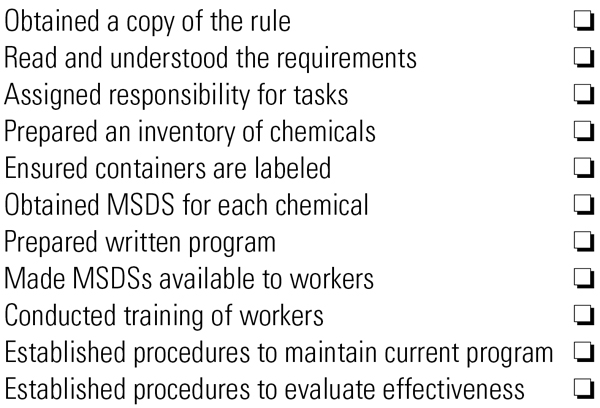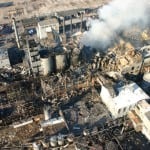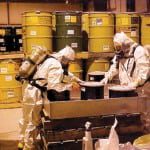In 1983, OSHA published its Hazard Communication (HAZCOM) Standard, which requires that the hazards of all chemicals used in the workplace be communicated to employees so that responsible protective measures can be taken. Today, HAZCOM remains near the top of the list of most frequently violated OSHA standards that result in a citation. The 1917 Halifax Explosion, one of the world’s largest nonnuclear explosions, testifies to what can happen when you don’t have—or don’t follow—an effective HAZCOM program.
According to the Occupational Safety and Health Administration (OSHA), more than 30 million U.S. workers are exposed to hazardous chemicals in their workplaces. To protect against chemical source illness and injury, OSHA published its Hazard Communication Standard (HCS), also referred to as HAZCOM, in 1983. The purpose of the HCS was to ensure that the hazards of all chemicals produced or imported are properly understood and that information concerning those hazards is conveyed to employers and employees.
The HCS standard requires those hazards to be communicated through a company’s HAZCOM to employees—typically, by using three separate means: container warning labels, material safety data sheets (MSDSs), and employee training. The HCS can be found in its entirety at 29 CFR 1910.1200, Hazard Communication.
Since the HCS rule became effective, it has been amended to address the fast-growing list of chemicals used in the workplace. OSHA currently regulates exposure to approximately 400 substances. The OSHA Chemical Sampling Information (CSI) file contains listings for approximately 1,500 substances; the Environmental Protection Agency’s (EPA’s) Toxic Substance Control Act (TSCA) Chemical Substances Inventory lists information on more than 62,000 chemicals or chemical substances; and some libraries maintain files of MSDSs for more than 100,000 substances. As you can see, there are numerous hazardous chemicals in the workplace, regulated or not.
Review Your HAZCOM Program
The accessibility and use of MSDSs should already be a part of your company’s standard business practices. Usually, they are included as part of the company’s right-to-know program. Typical HAZCOM training information that should be disseminated to all employees includes the following:
- Reason for a HAZCOM plan.
- The HCS and the standard operating procedure that addresses HAZCOM.
- MSDS books and their importance.
- Common types of materials expected to be encountered on-site.
- Container labeling and disposition.
- Building postings.
- Employee protection and responsibilities.
MSDSs are used worldwide to transmit detailed information about a chemical—for example, how it should be used, its effects, and how to protect against those effects. Many employers routinely review MSDSs before they purchase a chemical and compare it to acceptable alternatives in order to ensure that the least hazardous material is selected. This practice is perhaps the most important use of the MSDS, as it prevents unnecessary exposure to a hazardous chemical.
In addition, MSDSs help identify what protective measures should be used when handling the material, such as the type of respiratory protection to prevent an inhalation exposure or the type of glove material required to prevent skin exposure.
For MSDSs, warning labels, and employee training to be effective, the hazard information they convey must be complete and accurate. It’s therefore critically important for every company to obtain comprehensive and correct information about the hazards associated with particular chemicals. The process of evaluating available scientific evidence in order to determine if a chemical is hazardous, as required by the HCS, is referred to as a “hazard determination.” The hazard determination provides the basis for the information provided in its MSDS.
Chemical manufacturers and importers are required to perform hazard determinations on the chemicals they produce or import. Under the HCS, an employer that manufactures, processes, formulates, or repackages a hazardous chemical is considered a “chemical manufacturer.” Distributors and employers may also choose to conduct hazard determinations if they are concerned about the adequacy of hazard information for the chemicals they use in their business or distribute to others.
Two primary resources are required to conduct a hazard determination. First, complete, accurate, up-to-date literature and data concerning the chemical is required. Second, the analyst must be able to understand and interpret the information retrieved in order to identify and document the hazards. Specifically, any chemical that presents either a physical or health hazard is considered a hazardous chemical. The HCS uses the following definitions for physical and health hazards:
- “Physical hazard” means a chemical for which there is scientifically valid evidence that it is a combustible liquid, a compressed gas, explosive, flammable, an organic peroxide, an oxidizer, pyrophoric, unstable (reactive), or water-reactive.
- “Health hazard” means a chemical that may cause acute or chronic health effects in exposed employees, such as chemicals that are carcinogens, toxic or highly toxic agents, reproductive toxins, irritants, corrosives, sensitizers, hepatotoxins, nephrotoxins, neurotoxins, agents that act on the hematopoietic system, and agents that damage the lungs, skin, eyes, or mucous membranes.
Clearly, the HCS definition of a hazardous chemical is very broad but also very inclusive. The standard does not require chemical testing, only the collection and analysis of currently available data. Conservatively, untested chemicals are usually considered hazardous, as are chemicals with suspected hazardous properties.
An employer’s comprehensive HAZCOM program is the means of applying the HCS to company-specific conditions. The information is usually disseminated to employees in the form of a policy or procedure. Employees should receive HAZCOM training at the time they are assigned to work with hazardous chemicals, on a regular basis (such as annually), or following significant changes in the workplace. However, the HCS training provisions are not satisfied solely by having employees read product labels and/or the MSDSs. An employer’s HAZCOM training program is to be a forum for explaining to employees not only the hazards of the chemicals in their work area but also how to properly use the information (Figure 2).
 |
| 2. A HAZCOM compliance checklist. The Occupational Safety and Health Administration’s (OSHA’s) Hazard Communication Standard provides a very useful HAZCOM checklist to ensure that a company is in compliance with the standard. Source: OSHA |
OSHA’s “Top 10”
Despite the requirement for chemical manufacturers and importers to evaluate the hazards of the chemicals they produce or import, and the requirement to prepare labels and safety data sheets to convey the hazard information to their downstream customers, HAZCOM continues to rank high on OSHA’s “Top 10 Most Frequently Cited Standards.” In fiscal year 2010 (October 1, 2009 to September 30, 2010), for example, OSHA handed out approximately 94,000 citations related to HAZCOM violations. That put HAZCOM in third place, behind only fall protection and scaffolding violations. HAZCOM is a perennial top five finisher in OSHA citation issues year after year. Specific reasons for the citations usually fall into one of five main categories:
- Failure to develop and maintain a written HAZCOM program.
- Failure to maintain training.
- Lack of employee training.
- Failure to have an MSDS for each hazardous chemical.
- Failure to label each container with the identity of the hazardous chemical within.
OSHA publishes an annual list of the categories and reasons for citations as a way to alert employers so they can take steps to find and fix common, easily corrected hazards in the workplace before an OSHA inspection occurs. All the HCS standards, publications, training guides, and statistical information are available on the OSHA website (http://www.osha.gov).
Practical Applications of HAZCOM
Video training is effective because it matches the learning styles of about 95% of the population, which are visual and auditory. Furthermore, simultaneous audio and video increases information retention by as much as 50% over printed materials alone.
Employee training can be conducted in many different ways—including classroom instruction, interactive videos, and computer-based training, to name a few—and should provide opportunities for employees to ask questions to ensure that they understand the presented information. Moreover, videos and electronic media can be a cost-effective and time-efficient method for training employees, regardless of company size and complexity.
However, the key to effective training is creating genuine interest and motivating learners to use the information. Therefore, HAZCOM training must also have practical application in the field and instill an awareness of the logical consequences (often tragic) of ignoring the hard-learned lessons of history, such as those taught by the 1917 Halifax Explosion (see sidebar). When you read through the description of the Halifax events, how many HAZCOM deficiencies can you identify?
Hindsight is often 20/20, but if standard HAZCOM processes and procedures had been followed that wartime day in 1917, chances are that the explosion—which resulted in approximately 2,000 dead, 9,000 injured, 25,000 homeless, and, according to one conservative estimate, roughly $500 million (today’s dollars) in damages—would have been avoided.
— James M. Hylko (jhylko1@msn.com) is a POWER contributing editor.











